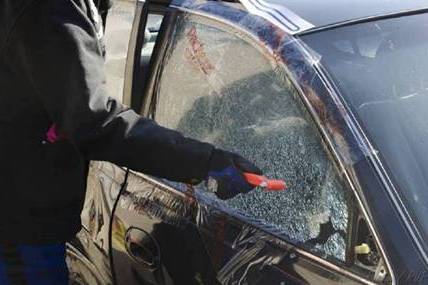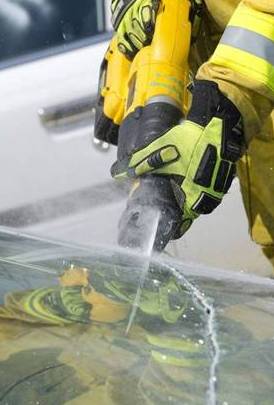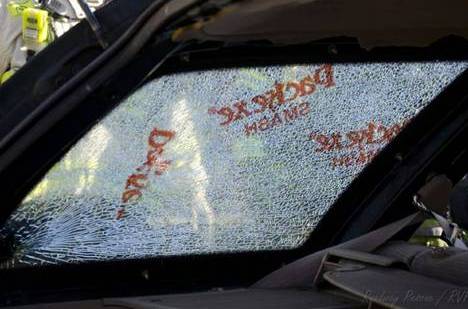By David Dalrymple
 At all the extrication programs you attend, you are taught to remove glass as needed and in a controlled manner as practical and possible. However, how many times do you attend the practical session and WHAM…SMASH goes the side and rear glass because it’s impressive to visually observe. Is that really what you should be doing?
At all the extrication programs you attend, you are taught to remove glass as needed and in a controlled manner as practical and possible. However, how many times do you attend the practical session and WHAM…SMASH goes the side and rear glass because it’s impressive to visually observe. Is that really what you should be doing?
 Displacing the vehicle glazing materials is usually referred to as “glass management” because you want to remove the glass in an orderly, managed process. Today, you can truly manage glass removal well with some of the new products on the market.
Displacing the vehicle glazing materials is usually referred to as “glass management” because you want to remove the glass in an orderly, managed process. Today, you can truly manage glass removal well with some of the new products on the market.
The two types of glass to which we have become accustomed are laminated and tempered safety glass; these are still the most widely used. Laminated glass is a “sandwich,” i.e., a series of layers of glass and plastic laminated together, while tempered (or safety) glass breaks into small granular fragments when shattered.
However, there are a few new curves out there. Enhanced protective glass (EPG) is basically a form of laminated glass placed in the side and rear windows. Dual-paned glass and polycarbonate glazing are also used. Some of these materials require a change in our methodology and tools for removing them.
You also need to add dust masks to your personal protective equipment (PPE) for glass management. Now, factor in the issues of rear glass hatches in SUVs and minivans; these glass hatches have a nasty habit of flying apart when broken because of the tension placed on them by the multiple hatch struts and the energy absorbed by the vehicle during the crash.
 Primarily, you deal with two forms of glass or glazing in vehicles today. Laminated glass is found in windshields, but it is increasingly found in the side and rear windows as well. This type of glass consists of two layers of glass with a layer of plastic sandwiched in between them. This type must be cut from the vehicle for it to be removed. This operation also produces glass dust, which is a respiratory hazard. Tempered glass is usually found in side and rear windows when broken glass falls into small granular pieces. Remember, today’s vehicles can load the glass with energy from the crash, so when it’s broken it can almost explode when that energy is released.
Primarily, you deal with two forms of glass or glazing in vehicles today. Laminated glass is found in windshields, but it is increasingly found in the side and rear windows as well. This type of glass consists of two layers of glass with a layer of plastic sandwiched in between them. This type must be cut from the vehicle for it to be removed. This operation also produces glass dust, which is a respiratory hazard. Tempered glass is usually found in side and rear windows when broken glass falls into small granular pieces. Remember, today’s vehicles can load the glass with energy from the crash, so when it’s broken it can almost explode when that energy is released.
In addition, watch out for glass in the hatches of vehicles. Not only might this glass become loaded with kinetic energy from the crash, but it might have up to four gas struts pushing on the glass, creating even more tension. When that glass is broken, it might explode, and you might even have struts pushing out toward you.
 Now let’s look at managing all of this broken and cut glass. Ideally, the laminated glass you cut and remove should be folded and slid under the vehicle and out of your way. If at all possible, remove tempered glass to the outside of the vehicle, away from your patient and the interior rescuer. However, in some vehicles, especially SUVs and minivans, you might encounter a lot of windows and/or a large window, which produce many glass particles. A good practice is to sweep this under the vehicle so you do not walk on it and our stabilization devices are on not on it either. Glass particles can be slippery—almost like marbles—when walked on.
Now let’s look at managing all of this broken and cut glass. Ideally, the laminated glass you cut and remove should be folded and slid under the vehicle and out of your way. If at all possible, remove tempered glass to the outside of the vehicle, away from your patient and the interior rescuer. However, in some vehicles, especially SUVs and minivans, you might encounter a lot of windows and/or a large window, which produce many glass particles. A good practice is to sweep this under the vehicle so you do not walk on it and our stabilization devices are on not on it either. Glass particles can be slippery—almost like marbles—when walked on.
Remember, both types of glass/glazing materials need to be removed in a safe, effective manner. Swinging a halligan tool like a baseball bat is neither safe nor effective. When glass is removed, protect your airway from glass dust and particles; always wear a dust mask (N95).
Also, make sure your own eye protection is in place. Tempered safety glass needs to be removed with a tool that exerts a large amount of force in a small area; usually, a spring loaded center punch of some kind will do the trick. The most advantageous of these involves a spring that is external from the barrel. However, there are some that use a hardened steel point with the force applied from swinging your arm. Next, clean out the window opening by pulling the glass onto the ground with a tool; not with your gloved hands. Laminated glass needs to be cut to be removed. Although you can use a wide variety of tools to facilitate this, remember that each one creates, to a greater or lesser extent, glass dust.
The most common tool for cutting glass is a glass saw such as a Glas-Master. However, a reciprocating saw is a popular choice. The key when using a reciprocating saw is choosing the correct blade. For cutting glass, a six-tooth-per-inch six-inch long blade is the best choice. However, do not use this blade to cut vehicle materials such as roof posts. You must protect your patient with protective cover and hard protection to funnel glass pieces away from the patient.
 The two materials available to rescuers to best manage glass are Packexe Smash (right) and Protecto Wrap. Packexe Smash is available in North America from ESI and is much akin to a clear film that is dispensed from a special user-friendly applicator. The film is perforated. However, the kit comes with a cutter. The film sticks well and adds enough strength so you can cut tempered glass when it is applied. On the flip side, when cutting laminated glass, dust can be greatly reduced by applying the film first and then cutting through the area where the film is applied. Even if the glass is wet, you can wipe the glass with a microfiber cloth and then apply the film.
The two materials available to rescuers to best manage glass are Packexe Smash (right) and Protecto Wrap. Packexe Smash is available in North America from ESI and is much akin to a clear film that is dispensed from a special user-friendly applicator. The film is perforated. However, the kit comes with a cutter. The film sticks well and adds enough strength so you can cut tempered glass when it is applied. On the flip side, when cutting laminated glass, dust can be greatly reduced by applying the film first and then cutting through the area where the film is applied. Even if the glass is wet, you can wipe the glass with a microfiber cloth and then apply the film.
Protecto Wrap is an adhesive rubber compound on one side and a smooth, brightly colored film on the other. The material comes in a roll which you can precut into sizes or cut it to size on scene. The upside to this material is that it can be used as sharp edge protection.
Both of these materials really can make a difference in your glass management tasks. And, both have the ability to handle not only glass management but sharp edge protection—truly a plus!
Photos by author.
DAVID DALRYMPLE is a career EMS provider for the RWJUH Emergency Medical Services in New Brunswick, New Jersey, and a volunteer firefighter/EMT/rescue technician for Clinton (NJ) EMS/Rescue. He has been actively involved with emergency services for 27 years. He is the education chair of the Transportation Emergency Rescue Committee-US (TERC), is a certified international level extrication assessor, and serves on the Expert Technical Advisory Board of the IETRI as their road traffic accident advisor. Certified as a NJ fire service instructor, he has been teaching transportation rescue topics for more than 16 years. He is the executive educator for Roadway Rescue LLC, an educational team for transportation rescue training. He is an ICET (Netherlands) certified registered International SAVER instructor. He writes on “Extrication Tactics“ for Fire Engineering and contributed to Fire Engineering‘s Handbook for Firefighter I and II (2009). He received the 2007 Harvey Grant award for excellence in rescue education. He is featured in “Training Minutes“ on vehicle extrication on fireengineering.com.


